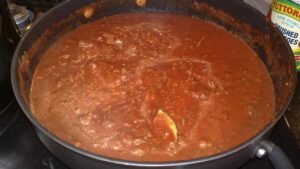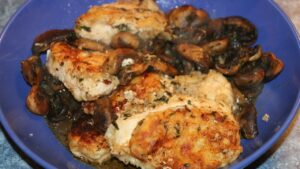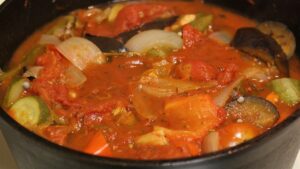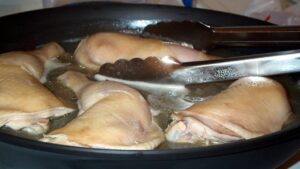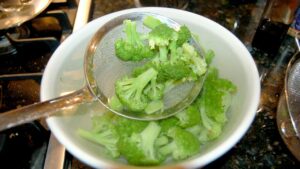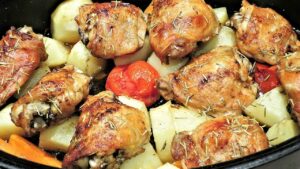What is Boiling?
Boiling is a widely used moist-heat cooking technique in which food is cooked in water that has reached its boiling point of 100 degrees Celsius.
To ensure uniform cooking, the food is fully submerged in the water. When the water is at a rolling boil, bubbles form and break quickly and vigorously across the entire surface of the liquid.
In contrast, a slow boil at around 95 degrees Celsius is a gentle simmer with slow and gradual formation of bubbles on the surface.
Depending on the type of food being cooked, it may be added to already boiling water or added to cold water and then heated to boiling.
Key Takeaways
- Boiling is an intense cooking technique.
- It is useful for pasta, some grains, and green vegetables.
- Boiling has the advantage of causing rapid evaporation of the liquid.
- Boiling is the best method for turning meat and vegetables into savory, nutrient-dense stocks.
- Boiling is an easy cooking technique that works well for large-scale cooking if you have a pot big enough for it.
- Boiling helps reduce sauces and concentrate flavors because it has a quick evaporation effect.
Understanding Boiling
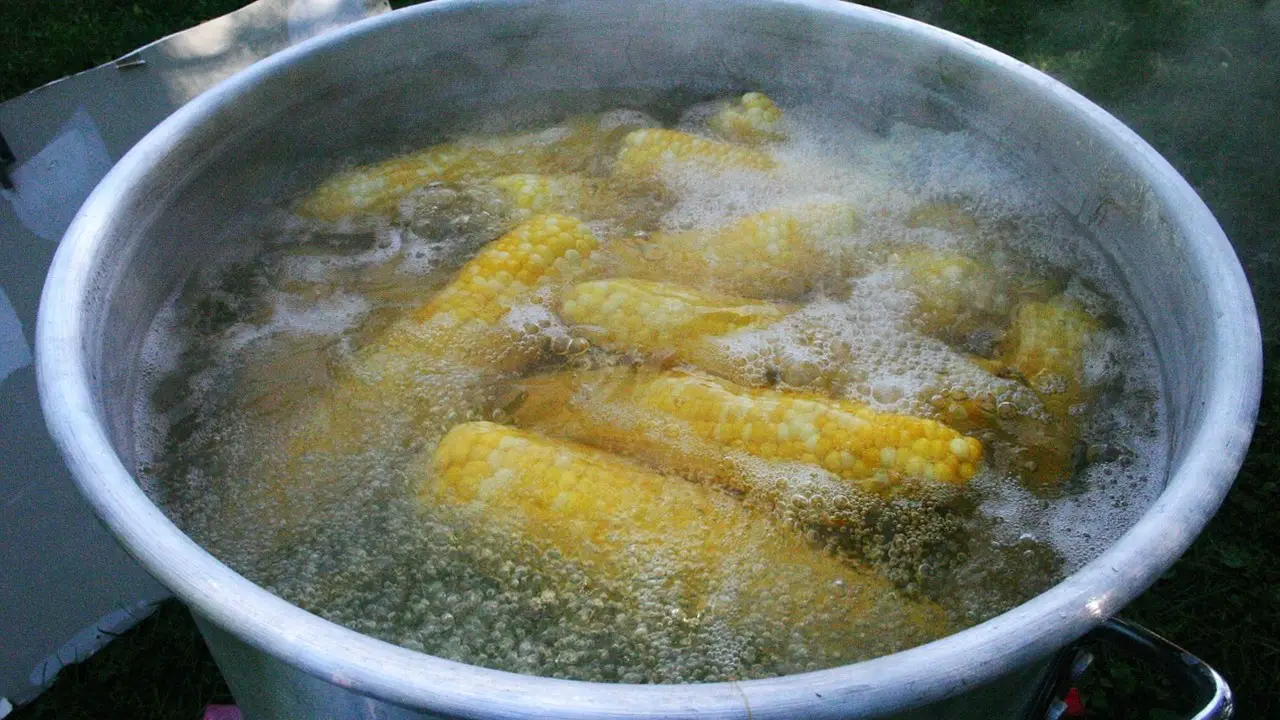
With this method, food is cooked at a temperature that is higher than the boiling point of water at sea level, which is 100 degrees.
When a liquid is boiling, bubbles appear on the surface and burst while the entire batch is vigorously stirred. Gaseous water vapor rises to the surface, creating bubbles.
The Upper Paleolithic period, archaeologists think that cooking food in hot stores with water used for boiling started around 30,000 years ago.
Others do believe that there were perishable containers that the people used to cook food by boiling.
But there was no physical source to support it but nearly 20,000 years ago in Japan there was some evidence of clay pottery where information about some of the sea foods was found.
This method of boiling is primarily used to cook meats and vegetables. Various cuisines made their appearance as per their mood.
Like the Chinese made its dictate with flavor, texture, and fresh color, then the U.S. and South for example made it with a blending of flavors and soft consistency which is usually protracted.
There are other processes like parboiling, semi boiled, half boiled all these are associated with boiling.
This is how boiling works for most ingredients in cooking.
When cooking pasta, churning the food in boiling water prevents sticking, keeps the food moving, and cooks the pasta quickly enough that it does not become soggy.
In a process known as blanching, green vegetables are thrown into boiling water to cook as quickly as possible so they retain their flavor and vibrant color.
They would lose a lot of their texture and their color if left to simmer in a covered pot. When reducing sauces, where the volume of the liquid is reduced and flavors are concentrated, boiling has the advantage of causing rapid evaporation.
Ingredients are boiled in water that may also contain salt, oil, or butter for flavor and texture. Usually, once the liquid comes to a boil, the food is added.
For pasta, some grains, and green vegetables, this intense cooking technique works well. Sauce reduction can benefit from boiling as well.
Starchy foods and more difficult proteins can be improved through boiling to make them more palatable.
Additionally, it makes grains, dried pasta, and dried legumes soft and tender by reviving them.
Importance of Boiling
Duration
Boiling may occur quickly or slowly, depending on the amount of time. Vegetables can be blanched in as little as a few minutes.
Potatoes and pasta can take anywhere from 10 to 15 minutes to prepare. For tender proteins and nutrient-rich stock, tough meats or poultry can be cooked for a very long time.
Taste
By boiling food instead of sautéing or frying it, the food retains its natural flavor. By reducing sauces, boiling also intensifies the flavor.
Texture
No one could eat a meal of uncooked quinoa, dried beans, or raw potatoes. Due to the breakdown and softening caused by boiling, grains, beans, and starchy vegetables become palatable and edible.
Nutrition
Boiling is the best method for turning meat and vegetables into savory, incredibly nutrient-dense stocks.
However, during the boiling process, a lot of water-soluble vitamins can leak into the cooking liquid. The nutrients in your boiling liquid may also be lost if you drain it.
To avoid this and maintain the nutritional value of the food you are cooking, you can serve the cooking liquid along with the dish. The benefit of this is seen in soups and stews.
What Temperature is Boiling?
Boiling happens when the liquid’s temperature reaches 212 degrees F or 100 degrees C.
The temperature of boiling is influenced by the pressure of the air around you at different altitudes.
Types of Boiling
Low Simmer
Early on, when the heat is still low, the process is called a slow simmer. In the pot, there is hardly any activity.
On the bottom of the pot, minuscule bubbles are forming. You will notice steam rising from the surface of the water and perhaps the occasional bubble bursting into the liquid.
Simmer
From low, the temperature is now rising to medium-high. Fewer bubbles are released into the water as gentle bubbling, and more are released into the area at the bottom of the pot.
Light Boil
From medium to medium-high heat, the simmer is happening quickly. The water is bubbling more violently, but the bubbles are still quite small.
Rapid Boil
High heat is now present as the water is rolling to a boil. The entire surface of the pot is covered in numerous large bubbles that are continuously evolving.
During a boil water advisory, it is advised to boil the water for one minute before consuming it.
Tips to Make Boiling Better
Boiling is a fundamental cooking technique used to prepare a wide variety of dishes, from pasta and rice to vegetables and soups.
Here are some tips to help you make boiling better:
Use a large pot: Make sure you use a pot that is large enough to accommodate the food you want to boil. This ensures that the food has enough space to cook properly, and that the water won’t boil over.
Add salt: Add salt to the water before boiling. This will enhance the flavor of the food you are cooking, and help it to cook evenly.
Bring water to a rolling boil: Wait until the water comes to a rolling boil before adding your food. A rolling boil is when the water is boiling vigorously and constantly, not just a few bubbles here and there.
Don’t overcrowd the pot: Avoid overcrowding the pot with too much food. This can cause the water temperature to drop, and your food may not cook properly.
Stir occasionally: Stir the food occasionally while it is boiling to ensure that it cooks evenly.
Don’t overcook: Be careful not to overcook your food. Overcooking can make it mushy, lose its flavor, and become less nutritious.
Use a timer: Use a timer to keep track of cooking time. Different foods require different amounts of time to cook, so it’s important to pay attention to the clock.
Use a slotted spoon: When removing food from the pot, use a slotted spoon. This will allow you to remove the food without taking too much water with it.
By following these tips, you can ensure that your boiling is done to perfection, and that your food is cooked just the way you like it.
Uses of Boiling in Indian Cuisine
In Indian cuisine, boiling is known as Ubalna. The purpose of this is to cook food in liquid while keeping the temperature of the liquid above boiling.
As a result, the water’s surface will continuously bubble and swirl as it cooks.
There are various boiling rates, from slowly boiling to quickly boiling, and the surface changes from barely audible bubbling to ferocious turbulence.
It is considered one of my favorite cooking techniques as it saves time and is nutritious at the same time.
Be it soups, eggs, vegs, and nonveg, boiling is considered the master of every cooking.
In Bengali cuisine, the concept of “sheddho” or “Bhate” is considered the best one.
The smashed vegetables and soups like dal are famous in Bengali cuisine and people are fond of it.
Conclusion
Boiling is a moist-heat cooking technique where food is cooked in water that has reached its boiling point of 100 degrees Celsius.
Boiling has various advantages such as quick evaporation, making grains and dried legumes soft and tender, and turning meat and vegetables into savory and nutrient-dense stocks.
Boiling also intensifies the flavor of the dish. It is an easy cooking technique that works well for large-scale cooking if you have a pot big enough for it.
The temperature of boiling is 212 degrees F or 100 degrees C, and there are mainly four types of boiling: low simmer, simmer, rapid simmer, and rolling boil.

